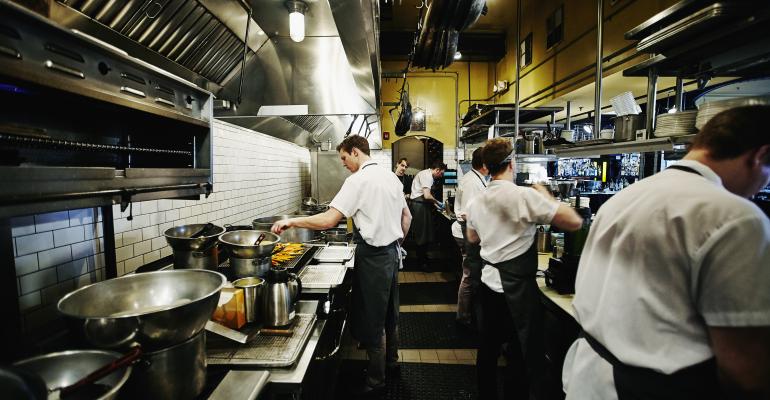Why are we talking about decarbonization and low-carbon kitchens?
Decarbonization is going to happen; we must reach Net Zero Carbon by 2050 if we are going to mitigate the most egregious effects of climate change. This is especially important for the foodservice industry, which is already seeing the effects of climate change, including droughts, pests, shifting crop outcomes, intense storms, and heat waves. All these climate changes impact foodservice operators’ ability to run stable and successful businesses. If you think about it, all the raw materials for foodservice come from the environment, and the very act of cooking, holding, and refrigerating food impacts that environment. So we must learn to walk a little lighter by lowering our carbon footprint.
How does decarbonization impact the restaurant industry? Where does commercial foodservice fit?
There are new codes and standards that require more aggressive decarbonization in the building sector, which is responsible for about 40% of carbon emissions. Commercial kitchens are the most energy intensive commercial buildings — they consume five to 10 times more energy per square foot than other commercial spaces — so foodservice is becoming more of a focus. Historically, foodservice has generally been overlooked when it comes to energy codes, but that is changing. So it’s important that operators prepare for new energy-efficiency standards and more kitchen electrification. This is not necessarily a bad thing; it’s a win-win if operators learn to upgrade their equipment in ways that are practical and cost effective. The long-term challenge is keeping better control of energy bills while creating better kitchens.
How can operators cut carbon without driving up the cost of operation? What resources are available to help?
The biggest carbon generator in a restaurant is the cooking equipment, so start in the kitchen. The cooking equipment is also one of the biggest energy wasters in the restaurant, so there’s lots of opportunity to save money while cutting carbon. The pathway is very straightforward: Operators need to purchase more energy efficient equipment. And by “energy efficient” we really mean “energy effective,” which translates into more food cooked in less time using less gas or electricity. Common pieces like high-efficiency gas fryers and ovens can often cut carbon emissions in half, dramatically reducing the energy bill and saving money. The reason many operators miss this opportunity is because nobody ever told them about the cost and performance benefits of efficient equipment. Sometimes operators do know about these benefits, but they can’t convince the purchasing department to justify any extra capital cost. And sometimes everyone is just so busy they don’t have time to upgrade the equipment specs. Given all these challenges, it’s tempting to take the “don’t fix it if it ain’t broke” approach, but every time we do the ROI math, efficient equipment wins big from a cost and food production standpoint, and it’s an effective way to cut carbon.
Those of us in the energy efficiency world needed a better way to educate and motivate restaurant operators to upgrade equipment. That’s why we created the Instant Rebates program. Instant Rebates are a straightforward way to educate operators: using direct dollar incentives to pay down the cost of equipment right at the point of sale. It’s simple: You purchase an efficient piece of equipment from a participating dealer, and you get a big discount right on the invoice. The rebate program started in California but it is now available in 12 other states as well, and behind the program is a team of experts ready to help operators overcome those challenges of equipment knowledge, ROI calculations, and time constraints. On the program website there’s a list with thousands of qualifying pieces of equipment as well as cost calculators, design guides, and seminars. If you have operations in CA, we can also set you up with energy consultations and site energy surveys. The Instant Rebates are a way to get paid while learning how to create better kitchens and cut carbon.
Are there other non-energy benefits that operators get when they create a low-carbon kitchen?
Yes! When we talk about the low-carbon kitchen of the future, the idea is to create a kitchen that is “Fast, Small, and Flexible” so that fewer staff can get more done, in a smaller space, over a wider period of time — and be more comfortable doing it. We also see benefits to food safety and overall energy management as more programmability is added to the cookline. High-speed and flexible cooking and refrigeration equipment like blast chillers, high-speed ovens, combi ovens, and sous vide systems will change the way kitchens operate for the better, while also cutting carbon, cutting food waste, and helping to solve labor challenges.
What other technologies will be part of restaurant decarbonization?
Besides high-efficiency cooking, holding and refrigeration, operators will need to embrace more advanced building systems including demand-controlled kitchen ventilation as well as next-gen plumbing and hot water design, which will also include heat pump water heaters. Heat pump space conditioning will also replace the standard AC units found in today’s stores. Long term and big picture, most restaurants will move toward full electrification, which is technically doable as long as operators design wholistically with the entire restaurant energy use in mind.
The low-carbon kitchen of the future is doable right now today. I encourage all operators to start learning and planning early, taking advantage of the available resources, so they can reap the benefits and stay ahead of the curve.
AUTHOR BIO
Richard Young is the Director of Outreach at the Frontier Energy FoodService Technology Center (FSTC), an unbiased, commercial foodservice, research-and-training facility known to most industry insiders as “fishnick.” He focuses his efforts on translating Frontier Energy’s 35 years of foodservice research into practical information. He is also the creator and author of the online Foodservice Energy Efficiency Expert (Fe3) training and certification program.





